Elucidating different pattern of immunoregulation in BALB/c and C57BL/6 mice and their F1 progeny
- PMID: 33452272
- PMCID: PMC7810711
- DOI: 10.1038/s41598-020-79477-7
Elucidating different pattern of immunoregulation in BALB/c and C57BL/6 mice and their F1 progeny
Abstract
Helminths are large multicellular parasites that infect one quarter of the human population. To prolong their survival, helminths suppress the immune responses of their hosts. Strongyloides ratti delays its expulsion from the gut by induction of regulatory circuits in a mouse strain-specific manner: depletion of Foxp3+ regulatory T cells (Treg) improves the anti-S. ratti immunity in BALB/c but not in C57BL/6 mice. In the current study we compare the hierarchy of immunoregulatory pathways in BALB/c, C57BL/6 mice and their F1 progeny (BALB/c × C57BL/6). Using multicolor flow cytometry, we show that S. ratti induces a distinct pattern of inhibitory checkpoint receptors by Foxp3+ Treg and Foxp3- T cells. Intensity of expression was highest in C57BL/6 and lowest in BALB/c mice, while the F1 cross had an intermediate phenotype or resembled BALB/c mice. Treg subsets expanded during infection in all three mouse strains. Similar to BALB/c mice, depletion of Treg reduced intestinal parasite burden and increased mucosal mast cell activation in S. ratti-infected F1 mice. Our data indicate that Treg dominate the regulation of immune responses in BALB/c and F1 mice, while multiple regulatory layers exist in C57BL/6 mice that may compensate for the absence of Treg.
Conflict of interest statement
The authors declare no competing interests.
Figures

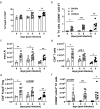
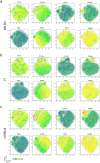
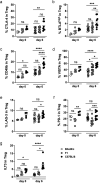
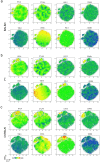
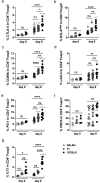
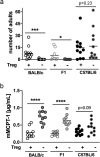
Similar articles
-
Foxp3⁺ regulatory T cells delay expulsion of intestinal nematodes by suppression of IL-9-driven mast cell activation in BALB/c but not in C57BL/6 mice.PLoS Pathog. 2014 Feb 6;10(2):e1003913. doi: 10.1371/journal.ppat.1003913. eCollection 2014 Feb. PLoS Pathog. 2014. PMID: 24516385 Free PMC article.
-
Basophils are dispensable for the establishment of protective adaptive immunity against primary and challenge infection with the intestinal helminth parasite Strongyloides ratti.PLoS Negl Trop Dis. 2018 Nov 29;12(11):e0006992. doi: 10.1371/journal.pntd.0006992. eCollection 2018 Nov. PLoS Negl Trop Dis. 2018. PMID: 30496188 Free PMC article.
-
Strongyloides ratti infection induces expansion of Foxp3+ regulatory T cells that interfere with immune response and parasite clearance in BALB/c mice.J Immunol. 2011 Apr 1;186(7):4295-305. doi: 10.4049/jimmunol.1001920. Epub 2011 Feb 18. J Immunol. 2011. PMID: 21335490
-
Efficient control of Plasmodium yoelii infection in BALB/c and C57BL/6 mice with pre-existing Strongyloides ratti infection.Parasite Immunol. 2012 Jul;34(7):388-93. doi: 10.1111/j.1365-3024.2012.01369.x. Parasite Immunol. 2012. PMID: 22554071
-
Strongyloides infection in rodents: immune response and immune regulation.Parasitology. 2017 Mar;144(3):295-315. doi: 10.1017/S0031182016000111. Epub 2016 Feb 24. Parasitology. 2017. PMID: 26905057 Review.
Cited by
-
ILC2s Control Microfilaremia During Litomosoides sigmodontis Infection in Rag2-/- Mice.Front Immunol. 2022 Jun 9;13:863663. doi: 10.3389/fimmu.2022.863663. eCollection 2022. Front Immunol. 2022. PMID: 35757689 Free PMC article.
-
Immunocompetent Mouse Models of Multiple Myeloma: Therapeutic Implications.Hematol Oncol Clin North Am. 2024 Apr;38(2):533-546. doi: 10.1016/j.hoc.2023.12.014. Epub 2024 Jan 16. Hematol Oncol Clin North Am. 2024. PMID: 38233233 Free PMC article. Review.
-
Development of a High-Color Flow Cytometry Panel for Immunologic Analysis of Tissue Injury and Reconstruction in a Rat Model.Cells Tissues Organs. 2023;212(1):84-95. doi: 10.1159/000524682. Epub 2022 Apr 22. Cells Tissues Organs. 2023. PMID: 35462366 Free PMC article.
-
Methylome-wide analysis in systemic microbial-induced experimental periodontal disease in mice with different susceptibility.Front Cell Infect Microbiol. 2024 Jul 16;14:1369226. doi: 10.3389/fcimb.2024.1369226. eCollection 2024. Front Cell Infect Microbiol. 2024. PMID: 39086605 Free PMC article.
-
Strongyloides questions-a research agenda for the future.Philos Trans R Soc Lond B Biol Sci. 2024 Jan 15;379(1894):20230004. doi: 10.1098/rstb.2023.0004. Epub 2023 Nov 27. Philos Trans R Soc Lond B Biol Sci. 2024. PMID: 38008122 Free PMC article. Review.
References
Publication types
MeSH terms
Substances
LinkOut - more resources
Full Text Sources
Other Literature Sources
Molecular Biology Databases

